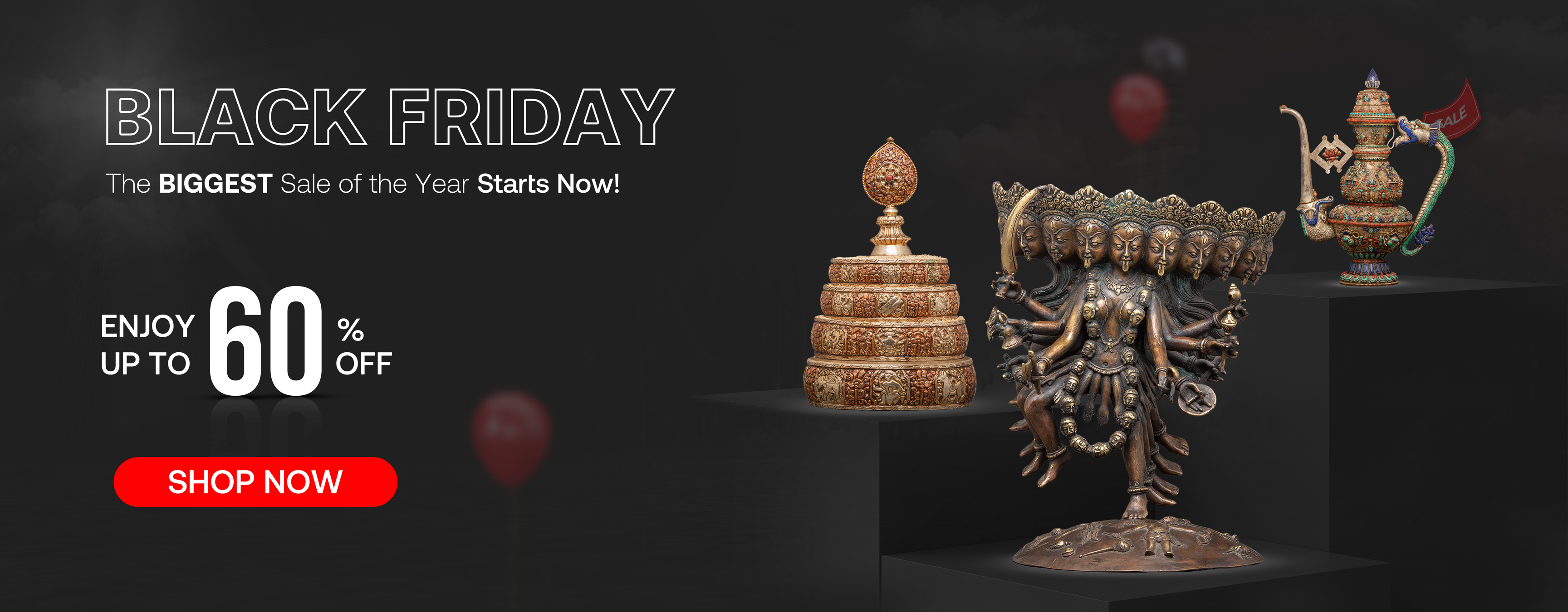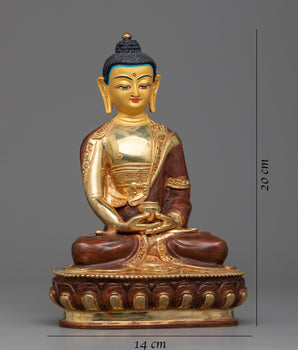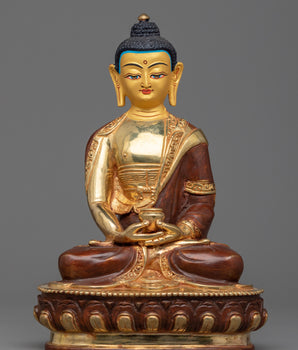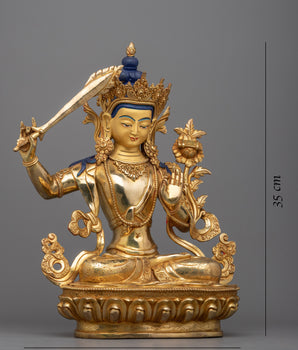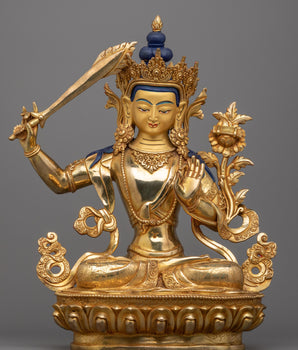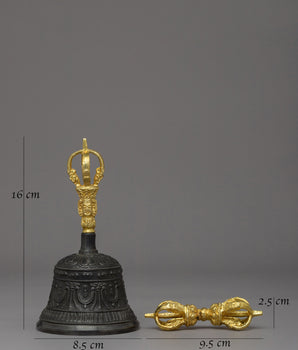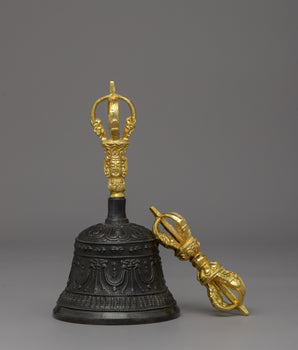Guardians, Tempters, and Guides: The Timeless Lessons of Buddhist Celestial Beings
Celestial Beings in Buddhism teach that reality goes beyond human limits, and mysterious and awe-inspiring beings inhabit many worlds. These beings are not merely mythic agents; they represent forces that create the universe and shape human existence. They are both feared as obstacles to spiritual growth and admired as wise Dharma supporters. The stories of these beings, which are preserved in scriptures, told as folk tales through the oral tradition, and depicted in temple images, maintain the abiding truths of karmic consequences, impermanence, and the fragility of good and evil while exploring everyday human struggles: ignorance is wisdom, fear is courage, and attachment is liberation. Our spiritual cosmos includes celestial beings such as the Nāgas, Garuḍas, Chhepu, and Devas, who guard hidden treasures and associate with heavenly places.
Journey Through the Realms of Existence

Buddhist cosmology describes six domains of existence, each indicating a different way of being dependent on karma. Humans inhabit the middle domain, capable of both suffering and awakening. While many gods and celestial beings inhabit these realms of being in vast numbers, Nāga, Garuḍa, Chhepu, and Deva belong in this larger framework:
1. Realm of Animals: This realm includes creatures driven by instinct and survival. The mythical beings Nāgas and Garuḍas often hover between this domain of existence and the domain of the divine—their creations have animal-like forms that reflect primal force; however, their intelligence and associated role place them close to the sacred.
2. Realm of the Asuras: The domain described for Asuras is filled with jealousy, dominion, and fighting to dominate existence. Garuḍas are not traditionally defined as Asuras, but they are aligned with Asuras, as they are always fighting with Nāgas—their suffering embodies the difficult, never-ending tension between desire and wisdom.
3. Realm of Humanity: This is a domain of rhythm and opportunity. Chhepu is not described as a cosmic being, but his role as a preserver in the Nepalese tradition connects him to the human world, which, given the ability to protect the Dharma, is most needed.
4. The Deva Realms: The higher heavens are filled with the brilliant Devas. These radiant beings inhabit various Deva realms, including Śakra's Heaven of the Thirty-Three and Brahma's world, which is the highest among the Brahma realms, encompassing both realms of exquisite pleasure and the luxuries of material existence. These worlds represent some of the finest fruits of constructive karma, and even the most blissful beings remain in samsara.
The Jātaka Tale of Nāga King Mucalinda
The Nāga King Mucalinda is the most popularly told story in the Buddhist tradition of the many Jātaka Tales. After the Buddha had gained his enlightenment under the Bodhi tree, he was still in profound peace, knowing he had understood the Four Noble Truths. But not long after, dark storm clouds built up overhead, and heavy rain threatened to pour down on him while he meditated.
Mucalinda, the serpent king, rises from the earth to protect the Buddha. He coils his body—intrepidly long and broad—around the Buddha and extends his great hood above the Buddha, entrapping his sacred body beneath a regal canopy. Mucalinda responded by continuing to protect the Buddha. Once the impending storm cleared, Mucalinda took human form, bowed before the Buddha, and retreated to his kingdom underneath the earth.
This Jātaka story is not only a story of supernatural protection, but it signifies how inner wisdom will arise to protect the mind when it is untroubled amidst storms of external nature.
The Majestic Celestial Beings of Buddhism
1. Nāga: The Protections of Wisdom

Nāga are serpent deities, often shown to be enormous cobras, sometimes depicted with additional heads, and sometimes in human form. In Buddhist teachings, the Nāga serve as protectors and also represent the hidden potential for knowledge. The account of Mucalinda, the king of the Nāga, is one of the most famous, wherein he provided shelter to the Buddha beneath a Bodhi tree while he meditated, and it rained. The Nāga live in palaces under the water or under the earth. They are the guardians of treasures, both material and spiritual. They also serve to remind practitioners that there is wisdom hidden beneath the appearances of the material world.
Iconography
- Form: Serpentine beings, often depicted as half-human (upper body) and half-serpent (lower body). Sometimes fully snake-like with multiple heads, usually seven or nine.
- Attributes: Jewel or water vessel; canopy of cobra hoods used as protection.
- Appearance: Usually green or blue, symbolizing water and hidden wisdom.
- Symbolism: Guardians of treasures, subterranean wisdom, and fertility.
- Context: Found in temple balustrades, gateways, and water shrines; famously protectors of the Buddha during meditation (e.g., Nāga King Mucalinda).
Explore Our Collection of Naga From Evamratna.
2. Garuḍa: The Unmatched Bird of Liberation

Garuḍa is a vast being that resembles a bird, although it is far more powerful and can fly at incredible speeds. In both Buddhist and Hindu traditions, Garuḍa is the sworn enemy of the Nāga, representing the dance of the eternal opposites. However, the Garuḍa in Buddhism are much more than destroyers of the Nāga—they symbolize the destruction of ignorance and attachment, just as Garuḍas can fly freely as birds. Garuḍa can fly almost limitless distances, and their large forms invoke both fear and awe. They also represent the courage to shatter illusions while embracing the way of liberation.
Iconography
- Form: Colossal bird-like creature with eagle wings and a human torso, referred to as "brahmavihara" or "concept of Brahma," and sometimes having a fierce visage and beak.
- Attributes: Wings are spread out within the form, sharp claws/paws, often depicted as devouring or paralyzing serpents.
- Appearance: The body is often a blazing red or gold color and is usually shown in motion, as if flying.
- Symbolism: Valor, overcoming fear, self-liberation, and overcoming relationship attachment. He is the eternal enemy of his brothers, the Nāgas, but he was reconciled through the Buddha's compassion.
- Context: A royal emblem of kingship in Southeast Asia (especially Thailand and Indonesia) and guardian figures over temple gates and also above thrones.
Explore Our Collection of Garuda From Evamratna.
3. Chhepu: The Protector of Dharma

Chhepu is a mythical being represented particularly in the Nepalese Buddhist and Hindu contexts. A protector figure with fierce attributes, he is very much aligned against fear as he stands as a protector against evil, disasters, and ignorance. Chhepu embodies alternatives to grand cosmological beings such as Nāgas and Garuḍas, suggesting a more practical and direct warrior protection against immediate fears and catastrophes in a specific time and place. While Chhepu stands to guard the patriarchy of truth, he serves as a reminder to practitioners and devotees that compassion and strength guard both the paths of Dharma.
Iconography
- Form: A ferocious spirit with bulging eyes, occasionally a half-animal with grotesque limbs and features.
- Attributes: Represent weapons (sword, club) or weapons, frequently with snarling fangs.
- Appearance: Dark color, typically on temple supports or doors.
- Meaning: Watchfulness, guardian of Dharma, deterrent to evil forces.
- Context: Especially prevalent in Newar Buddhist art, it has connections to Tibetan Dharmapālas and Japan's Niō guardians.
4. Devas: The Heavenly Beings of Bliss

Deva states are another realm of existence beyond our own. Devas are beautiful beings with long lives of bliss, beauty, power, and happiness. They are not gods but are caught in samsara—the continuous cycle of rebirth and death. Devas may be considered symbols of the rewards of favorable karma and remind us that even the best pleasures of the universe are temporally fleeting. Devas encourage practitioners to break free from the cycle of birth and rebirth, from the shining beings of the Heaven of the Thirty-Three to the ethereal beings of the Formless Realms—liberation is even above divine pleasure and bliss.
- Indra (Sakra): He is defined in many of the Buddhist stories as the protector of the Dharma. He appears frequently in many stories, supporting both practitioners and the Buddha, and he symbolizes the divine protection of truth.
- Brahmā Sahampati: A highly esteemed being from the Brahma world. In broad terms, he persuaded the Buddha, after the moment of enlightenment, to share his experience with the world out of compassion for all beings.
- Māra: Often personified as a tempter or adversary. He is a powerful Deva and is classified as a Deva of the desire realm. He embodies illusion, attachment, and distractions on the path to awakening.
- Kubera: As the Guardian King of the north, Vaiśravaṇa is associated with wealth, prosperity, and protection. He is one of the Four Heavenly Kings, who guard the four directions of the world, creating balance and protecting the Dharma.
- The Four Great Kings (Chatur Maharaj): Dhṛtarāṣṭra (East), Virūḍhaka (South), Virūpākṣa (West), and Vaiśravaṇa (North). These heavenly defenders stand at the four cardinal points of the world, watching over the Dharma and sentient beings.
- Tāvatiṃsa Devas: The deities of the Heaven of the Thirty-Three under the lordship of Śakra. Although the Tāvatiṃsa Devas exist in a radiant and blissful state, they remind practitioners that even the happiness found in heaven is impermanent.
Explore Our Collection of Indra From Evamratna.
Iconographic Characteristics of Devas
Body: Celestial, human-like figures are radiant and magnificent (more luminous and more glorious than the typical human who has led a beneficial life) and wear crowns, jewels, and flowing robes.
Attributes: Each Deva may be holding items that signify authority or power:
- Śakra (Indra): a Vajra (thunderbolt) and riding on an elephant.
- Brahmā Sahampati: He has four faces with joined palms, indicating reverence.
- Māra: Wields weapons, sometimes rides a war elephant, and has armies of demons surrounding him.
- Vaiśravaṇa: A jewel-spitting mongoose or an umbrella or a banner.
- The Four Heavenly Kings: Possess musical instruments, swords, eyes, or jewels, depending on the direction they represent.
- Appearance: Has a golden skin tone and a halo. May be surrounded by attendants.
- Symbolism: As a depiction, the Devas are the rewards of favorable karma, divine, auspicious, and majestic. The Devas are, however, symbolic of impermanence (because they, too, are subject to rebirth).
- Context: Seen in their role as protectors (i.e., Four Kings) positioned at temple gateways or in cosmology paintings just above the human realm.
Celestial Beings Across Cultures: Shared Roots, Unique Forms

Changu Narayan Temple (Photo From Holidays to Nepal)
These spiritual beings are part of the earliest layers of South Asian spiritual imagination. Many of them, like Nāgas and Garuḍas, come from Vedic and Hindu traditions and were absorbed into subsequent Buddhist cosmology without being; instead, they were reinterpreted in a Buddhist context as guardians of Dharma and embodiments of inner struggle. These beings were thus coextensive with the Dharma as it pervaded Asia, evolving in every culture they encountered.
In Southeast Asia, Nāgas explicitly inhabit the realm of temple architecture—at Angkor Wat in Cambodia, where a serpent balustrade traces the perimeter of every temple promenade, representing their transitional role as cosmic traverses. In Thailand, the Nāga is celebrated each year with a Naga Fireball Festival, where peculiar glowing orbs rise from the Mekong River, which locals believe represent gifts from serpent deities. The Garuḍa is emblazoned as Indonesia's national emblem and commonly carved at the apex of temple gates in Bali and Java. In Sri Lanka and Southeast Asia, they merged with folk tales and dominate stories like the Jātaka.
In Nepal, guardians, such as Chhepu, are carved on the struts and entrances of temples as indigenous spirits of protection. In China and Japan, temple gates may be flanked by the Four Heavenly Kings (Cāturmahārājikas), fierce guardians of the Dharma. In manuscripts, such as the Pali Canon's Dīgha Nikāya, Devas and Brahmas are mentioned in texts while retaining their cosmological consequences for hundreds of years. Over time, these beings evolved from myth to living members of Buddhist culture through art, festivals, and texts.
Symbolism and Teachings of Celestial Beings in Buddhism
|
Celestial Being/Deity |
Meaning |
Spiritual Teaching |
|
Naga |
Subconscious hidden wisdom |
Things not visible will always show that wisdom is underneath; patience and meditation bring us to the inner truth. |
|
Garuda |
Courage, freedom from attachment, |
Rise against the limitations; face illusions and obstacles with courage and strength. |
|
Chhepu |
Vigilance, sacrifice of virtue |
Protect Dharma and value vigilance against negative things that may tempt you. |
|
Indra (Sakra) |
Rulership/protection of Dharma |
The power of leadership lies in the responsibility to serve truth; leadership under wisdom, compassion, and care is needed to keep harmony. |
|
Brahma Sahampati |
Compassion, encouragement |
Share wisdom generously; that encourages other people to be in truth. |
|
Kubera |
Prosperity, guardianship |
Generosity is true wealth; let go of all advantage, share any treasure enthusiastically, and protect both material and spiritual. |
|
Dhritarashtra |
Music, harmony, protector of the east |
You will protect your path with harmony and mindfulness. |
|
Virudhaka |
Growth, expansion, and protector of the south |
Awareness must be balanced with exercises of restraint; unrestricted desire is the demise of growth. |
|
Virupaksa |
Sight, awareness, protector of the west |
A strong sense of Awareness can see through deceit and helps to avoid ignorance. |
|
Mara |
Temptation, illusion, desire |
Obstacles and doubts are in you; overcome them, and you will find liberation. |
|
Vaiśravaṇa |
Wealth, power, protector of the north |
Do not neglect to employ your material power with spiritual responsibility. |
|
Tāvatiṃsa Devas |
Bliss, joy, divine beauty |
Heavenly pleasure is also impermanent, but true freedom is to go beyond those worldly things. |
Philosophical Dimension of Celestial beings
The understanding of celestial beings expresses diversity across Buddhist traditions.
Theravāda Concept: Holds that beings such as Nāgas, Garuḍas, and Devas are real entities that inhabit different realms and serve as bearers of karmic law. The Theravāda tradition authenticates its real existence based on explanations in the Pali Canon, where the Buddha often interacts with them. Still, these types of beings are no less subject to samsara and are not ultimate refuges.
Mahayana Concept: Celestial beings are acknowledged as beings in some sense, although their forms may often be referred to symbolically as mind representations and archetypes of spiritual qualities. The Nāga may portray the type of hidden wisdom that lies beneath delusion, while Mara represents the psychological power that impedes awakening. In Vajrayana, practitioners may visualize these beings in meditation as manifestations of inner forces that can be directed and utilized to aid development.
Therefore, the Theravāda tradition emphasizes a cosmological view of the beings. In contrast, the Mahayana and Vajrayana traditions highlight their archetypal and symbolic meanings that promote some degree of growth in enlightenment.
Contemporary Relevance of Celestial beings

The archetypal beings of Buddhism have relevance even today, both in traditional cultures and in contemporary psychology and literature. The nāga, depicted as a serpent and symbolizing the unconscious mind—those fears, wishes, and buried wisdom and knowledge that come to light in meditation and reflection; garuḍa provides an impetus for courage and freedom from attachment and unwanted patterns holding you down; chhepu, the guardian of one's practice, suggests you need mindful awareness, attention, and inner strength to guard your values in daily life; Mara, the powerful tempter, is evident when we succumb to distractions, addictions, and self-doubt, which obscure our purpose and intention; mindfulness provides the opportunity to know when 'Mara is near,' and devas, who shine through beauty, joy, and prosperity, also remind us of impermanence, teaching us that even pleasure at its peak cannot endure. The beings provide archetypes of meaning, relevance, and purpose that can lead us toward greater self-awareness and spiritual transformation.
Conclusion: Cosmic Archetypes and Their Enduring Role in Buddhist Thought
The celestial beings Nāgas, Garuḍas, Chhepu, Devas, and Mara have distinct qualities inspired by ancient texts, and they are also unquestionable features of our human condition; they are the timeless manifestations of spiritual possibility throughout our human experience. From rituals in different cultures and art, they still inspire awe, respect, wariness, and trust in those who follow them as they remind practitioners that their quest for awakening is made possible not only through their inner struggle; they are influenced by other realms, too, including protective, seductive, and wise forces. Whether they take part in a literal Theravāda cosmology or a figurative one, as seen in Mahāyāna and Vajrayāna, they are still ongoing and recognizable archetypes illuminating truths about being courageous, vigilant, aware of impermanence, and ultimately, liberated.
In this modern time, they speak explicitly to our psychological and spiritual issues: Nāga represents the wisdom from within that is often hidden; Garuḍa indicates the freedom that comes when living fearlessly; Chhepu symbolizes the vigilance necessary for maintaining our integrity; Devas remind us that, as fleeting as joy is, it can still exist in the present moment; and Mara serves as a cautionary reminder of how easily we can lose sight of the path we quietly create—and just that becomes the reason for distraction and craving. Together, they suggest an old way of serving spiritual lessons that ground us, balancing the bridge between myth and reality, the essence of history, and the now. In keeping these beings alive, we not only keep the truths they represent alive, but we also conclude, guiding ourselves back to the essential purpose of Buddhism—awakening to freedom beyond realms, beyond the divine, too.






